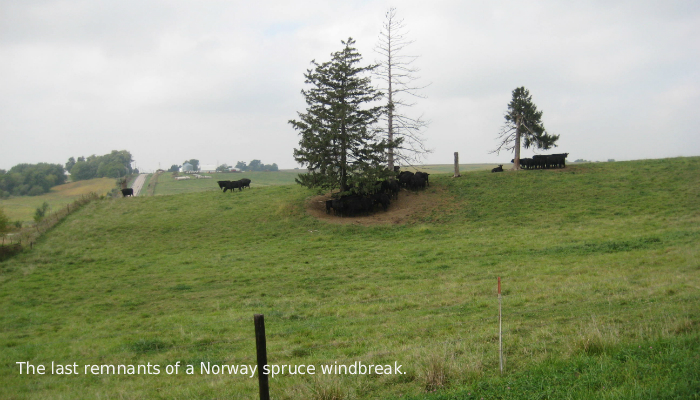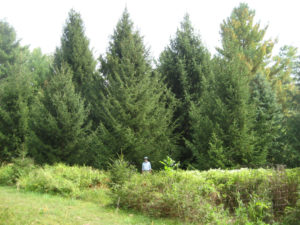The Peddler’s Pines

by Lon Drake
The railroad arrived in Iowa City on the last day of 1855, which offered still more impetus for settlement. Items like window glass, cut nails, and roofing tin were now readily available from back east. Settlement moved into the timbered tracts first, because here was lumber for houses and barns, split rails for fences, firewood, ashes for soap, acorn mast for the hogs, herds of deer, fuel for sawmills and grain mills, and shelter from that godawful wind.
Hilltops were prime locations for farmsteads because of favorable drainage away. In an era without paving, the mud season lasted for months, followed by the dust season. And the “drainage” wasn’t all water. But the hilltops also had a clear view of the Arctic Circle in winter. And that godawful wind.
The need for windbreaks around farmsteads created an industry, and by at least 1880, peddlers traveled door-to-door with a buckboard full of seedling conifers for sale.
When we arrived in Iowa in 1968, these windbreaks were usually three rows deep, and in their prime at 60 or 70 or 80 years old. Elderly folks remembered planting them when they were children – the daily buckets of water carried from the pump, and the struggle to protect them from the cows and sheep. And they sometimes referred to the trees as “the peddler’s pines.”
My neighbors didn’t seem to recall which species they had originally planted, but the survivors by around 1970 were almost always white pine and Norway spruce.
But the prairie wind that the trees were planted to shelter people from, was unrelenting. Today, after weathering more than a century of storms and the sometimes accompanying drought, lightning strikes, fire, and ice, the survivors are in rather rough shape.
However, the factors that lead to loss of most of the original farmstead windbreaks were not factors of nature. During our war on Vietnam, Earl Butz, Nixon’s Secretary of Agriculture, told farmers to plow “fence row to fence row,” and many did by removing the old windbreaks. And with energy so cheap today (meaning heavily subsidized), it is simpler to just turn up the thermostat in a drafty farmhouse than to upgrade or replant a windbreak. And today’s huge farm machinery needs to be working as many acres as possible to pay it off.

A young Norway spruce windbreak, two rows behind me, and a couple of youngsters in deer cages up front.
So farmstead windbreaks have become obsolete for modern agriculture, and more vanish every year. On some farms, these were already the last scraps of habitat remaining, and Iowa continues to be converted into an industrial landscape. This makes our efforts, however small, even just taking a grandchild or some Brownie Scouts out to plant a few trees, more worthwhile. There are many benefits to planting additional trees, from mitigating increased CO2 levels to creating habitat for wildlife. Take for example crossbills and a few other bird species. They have specifically evolved to feed on the seeds in conifer cones, and without these available, they must migrate elsewhere in winter. Unfortunately, “elsewhere” has similar problems, and loss of habitat is widespread, especially affecting the specialists.


